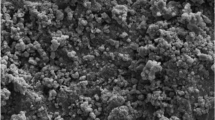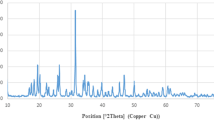Abstract
The microbial mediated synthesis of nanoparticles will be more effective for chemotherapeutic applications because microbes are well known attractive sources for the various biologically active biomolecules. The present study was designed to investigate the anticancer effect of zinc oxide nanoparticles (ZnO NPs) synthesized by Bacillus cereus PMSS-1 strain on human melanoma A375 cells. The synthesized ZnO NPs was characterized by UV-spectroscopy, X-ray diffraction (XRD) investigation, transmission electron microscope (TEM), energy dispersive X-ray (EDX), and Fourier transform infrared (FTIR) examination. The results show that the ZnO NPs exhibited concentration-dependent cytotoxicity on A375 cells, and induced the apoptosis as evidenced by the increased lipid peroxidation (LPO), diminished activities of an antioxidant such as superoxide dismutase (SOD), catalase (CAT) and glutathione peroxidase (GPx). Moreover, the administration of synthesized ZnO NPs increased reactive oxygen species (ROS) production and reduced mitochondrial membrane potential (MMP) in A375 cells. The western blot analyses explored that the anti-apoptotic protein Bcl-2 expression was significantly downregulated, whereas, the expression of pro-apoptotic proteins such as p53, Bax, Caspase-3 and Caspase-9 were significantly upregulated in ZnO NPs treated A375 cells. Therefore, the B. cereus synthesized ZnO NPs could be used for human malignant melanoma after proper in vivo studies.











Similar content being viewed by others
References
M. S. Goldberg, J. T. Doucette, H. W. Lim, J. Spencer, J. A. Carucci, and D. S. Rigel (2007). J. Am. Acad. Dermatol. 57, 60–66.
T. Marugame and M. Z. Zhang (2010). J Clin. Oncol. 40, 710.
V. Stratigos, S. Nikolaou, C. Kedicoglou, I. Antoniou, G. Haidemenos. Stefanaki, and A. D. Katsambas (2007). J. Eur. Acad. Dermatol. Venereol. 21, 56–62.
W. Sun and L. M. Schuchter (2001). Curr. Treat. Options Oncol. 2, 193–202.
S. E. McNeil (2009). Wiley Interdiscip. Rev. Nanomed. Nanobiotechnol. 1, 264–271.
J. Zhou, N. S. Xu, and Z. L. Wang (2006). Adv. Mater. Deerfield Beach Weinheim 18, 2432.
C. Hanley, J. Layne, A. Punnoose, K. M. Reddy, I. Coombs, A. Coombs, et al. (2008). Nanotechnology 19, 295103.
K. Huang, H. Ma, J. Liu, S. Huo, A. Kumar, T. Wei, et al. (2012). ACS Nano. 6, 4483–4493.
J. W. Rasmussen, E. Martinez, P. Louka, and D. G. Wingett (2010). Expert. Opin. Drug. Deliv. 7, 106–377.
R. M. Tripathi, A. S. Bhadwal, R. K. Gupta, P. Singh, A. Shrivastav, and B. R. Shrivastav (2014). J Photochem Photobiol B. https://doi.org/10.1016/j.jphotobiol.2014.10.001.
M. Saravanan, V. Gopinath, M. K. Chaurasia, A. Syed, F. Ameen, and N. Purushothaman (2018). Microb Pathog. https://doi.org/10.1016/j.micpath.2017.12.039.
H. Okhawa, N. Ohishi, and K. Yagi (1979). Anal. Biochem. 95, 351–358.
Z. Y. P. Kakkar, B. Das, and P. N. Viswanathan (1984). Indian J. Biochem. Biophys. 21, 130–132.
K. A. Sinha (1972). Anal. Biochem. 47, 389–394.
M. S. Moron, J. W. De Pierre, and B. Mannervik (1972). Biochim. Biophys. Acta 82, 67–70.
C. P. Wang, E. Myung, and B. H. Lau (1993). J. Immunol. Methods 159, 131–138.
L. V. Johnson, M. L. Walsh, and L. B. Chen (1980). Proc. Natl. Acad. Sci. USA 77, 990–994.
M. Keuling, K. E. Felton, A. A. Parker, M. Akbari, S. E. Andrew, and V. A. Tron (2009). PLoS ONE 4, e6651.
M. B. Atkins, M. T. Lotze, L. P. Dutcher, R. I. Fisher, G. Weiss, K. Margolin, J. Abrams, M. Sznol, D. Parkinson, M. Hawkins, et al. (1999). J. Clin. Oncol. 17, 2105–2116.
D. Guo, C. Wu, H. Jiang, Q. Li, X. Wang, and B. Chen (2008). J. Photochem. Photobiol. B 93, 119–126.
K. M. Reddy, F. Kevin, B. Jason, G. Denise, H. Cory, and P. Alex (2007). Appl. Phys. Lett. 90, 213902–213903.
J. Santhoshkumar, S. Venkat Kumar, and S. Rajeshkumar (2017). Resource Efficient Technol. 3, 459–465.
J. Bérdy (2005). J Antibiot. https://doi.org/10.1038/ja.2005.1.
A. Hamdache, A. Lamarti, and I. G. Collado (2011). J. Nat. Prod. 74, 893–899.
K. R. Meena, A. Sharma, and S. S. Kanwar (2017). Ann. Pharmacol. Pharm. 2, 1–5.
F. Baruzzi, L. Quintieri, M. Morea, and L. Caputo (2011). Commun. Curr. Res. Technol. Adv. 2, 1102–1111.
J. A. Trischman, P. R. Jensen, and W. Fenical (1994). Tetrahedron Lett. https://doi.org/10.1016/S0040-4039(00)77249-2.
G. R. Pettit, J. C. Knight, D. L. Herald, R. K. Pettit, F. Hogan, J. R. V. Mukku, and J. Chapuis (2010). J Nat Prod. https://doi.org/10.1021/np800603u.Antineoplastic.
Y. Li, Y. Xu, L. Liu, Z. Han, P. Y. Lai, X. Guo, and P. Qian (2012). Mar Drugs. https://doi.org/10.3390/md10020319.
M. L. V. Kumar, B. Thippeswamy, and P. V. Raj (2014). Appl Biochem Microbiol. https://doi.org/10.1134/S0003683814060088.
H. U. Simon, A. Haj-Yehia, and F. Levi-Schaffer (2000). Apoptosis 5, 415–418.
P. N. Shilpa, V. Sivaramakrishnan, and S. Niranjali Devaraj (2012). Asian Pac. J. Cancer. Prev. 13, 2753–2758.
S. Karthikeyan, S. L. Hoti, and N. R. Prasad (2015). Biomed. Pharmacother. 70, 274–282.
E. A. Murphy, B. K. Majeti, L. A. Barnes, M. Makale, S. M. Weis, K. Lutu-Fuga, W. Wrasidlo, and D. A. Cheresh (2008). Proc. Natl. Acad. Sci. USA 105, 9343–9348.
V. Sharma, D. Anderson, and A. Dhawan (2012). Apoptosis 17, 852–870.
C. Y. Looi, B. Moharram, M. Paydar, et al. (2013). BMC Complement Altern. Med. 13, 166.
M. Farnebo, V. J. Bykov, and K. G. Wiman (2010). Biochem. Biophys. Res. Commun. 396, 85–89.
M. J. Akhtar, M. Ahamed, S. Kumar, M. M. Khan, J. Ahmad, and S. A. Alrokayan (2012). Int. J. Nanomed. 7, 845–857.
Acknowledgements
The authors would like to thank Yaazh Xenomic laboratories, Coimbatore for excellent technical and bioinformatics assistance.
Funding
This research did not receive any specific grant from funding agencies in the public, commercial, or not-for-profit sectors.
Author information
Authors and Affiliations
Contributions
RP performed isolation and identification of bacterial strain, nanoparticle synthesis, and in vitro anticancer experiments, biochemical analyses and wrote the manuscript. RR performed the statistical data analyses. YK performed western blot analyses, software and data validation and edited manuscript. SD designed and supervised the study, and English corrected the manuscript.
Corresponding author
Ethics declarations
Conflict of interest
The authors declare that they have no conflict of interest.
Additional information
Publisher's Note
Springer Nature remains neutral with regard to jurisdictional claims in published maps and institutional affiliations.
Rights and permissions
About this article
Cite this article
Parthasarathy, R., Ramachandran, R., Kamaraj, Y. et al. Zinc Oxide Nanoparticles Synthesized by Bacillus cereus PMSS-1 Induces Oxidative Stress-Mediated Apoptosis via Modulating Apoptotic Proteins in Human Melanoma A375 Cells. J Clust Sci 33, 17–28 (2022). https://doi.org/10.1007/s10876-020-01941-1
Received:
Accepted:
Published:
Issue Date:
DOI: https://doi.org/10.1007/s10876-020-01941-1




